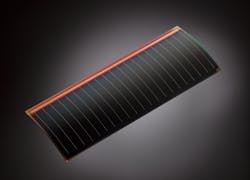Luminescent solar cell that emits light achieves record efficiency
While the concept seems fundamentally counterintuitive, researchers at the University of California–Berkeley (UC Berkeley) have suggested and demonstrated that a highly efficient solar photovoltaic (PV) cell is also an efficient emitter of photons. A luminescent solar cell prototype developed by Alta Devices (Santa Clara, CA), the company that is commercializing the technology, achieved a 28.8% optical-to-electrical conversion efficiency—record performance for a single-junction PV cell and fast approaching the 33.5% theoretical Shockley-Queisser efficiency limit.
Based on the thermodynamic link between absorption and emission, a solar cell that easily emits photons also produces a higher voltage. When absorbed sunlight in the gallium-arsenide structure produces electrons and holes, these carriers have no place to go at the open-circuit condition. The carrier-density buildup causes external fluorescence that balances the incoming sunlight. An external fluorescence improvement from high carrier density also occurs in the best light-emitting diode (LED) devices. High carrier density produces high voltage and likewise, improved optical-to-electronic conversion efficiency. That is, the best solar cells behave just like ideal LEDs, with very low nonradiative losses and internal luminescence efficiency values much greater than 90%. Contact Owen Miller at [email protected].

Gail Overton | Senior Editor (2004-2020)
Gail has more than 30 years of engineering, marketing, product management, and editorial experience in the photonics and optical communications industry. Before joining the staff at Laser Focus World in 2004, she held many product management and product marketing roles in the fiber-optics industry, most notably at Hughes (El Segundo, CA), GTE Labs (Waltham, MA), Corning (Corning, NY), Photon Kinetics (Beaverton, OR), and Newport Corporation (Irvine, CA). During her marketing career, Gail published articles in WDM Solutions and Sensors magazine and traveled internationally to conduct product and sales training. Gail received her BS degree in physics, with an emphasis in optics, from San Diego State University in San Diego, CA in May 1986.
